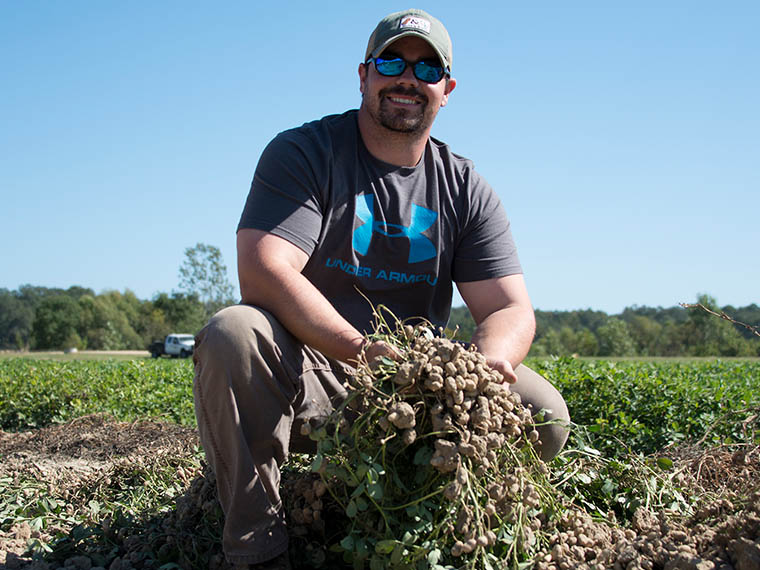The information presented on this page may be dated. It may refer to situations which have changed or people who are no longer affiliated with the university. It is archived as part of Mississippi State University's history.
In row-crop production, there is a time to plant, a time to harvest, and in between, a time to apply herbicide, insecticide, fungicide, and fertilizer. For agronomy master's student, Chad Abbott, determining the best timing in peanut production drives his award-winning research, which is making an impact for producers across the Southeast.
His research is centered on helping producers increase yields and improve profits by researching and then recommending management techniques for timing of applications in peanuts.
The Augusta, Georgia native first became interested in peanuts while working as an undergraduate research scholar for the University of Georgia. Abbott attended Abraham Baldwin Agricultural College in Tifton, Georgia, where he earned an undergraduate degree in forestry, a profession shared by his father and brother. Just a stone's throw away from his college was the University of Georgia Coastal Plain Experiment Station, where he worked in row-crop agriculture. Agronomy sparked his interest and assistant extension/research professor Dr. Jason Sarver provided the opportunity for him to continue his work as a master's student at Mississippi State.
One of his projects, which was started in 2014 by MAFES entomologist Dr. Jeff Gore, looked at complete canopy defoliation in peanuts to simulate the effects of caterpillars. In 2015 and 2016, Abbott and several other students pulled leaves from peanuts by hand at 35, 50, 65, 80, 95, and 110 days after plants had emerged.
The research sought to determine when defoliation caused significant yield loss. In addition to this project, the team also looked at differing levels of defoliation. They assessed defoliation from zero to 100 percent at 20 percent intervals during two separate timings. The first timing was 40 days after emergence, which represented the late vegetative stage or just prior to peak flowering. The second timing occurred 80 days after emergence, which is the peak reproductive stage in peanuts.
The research found that the plants were able to recover from all levels of defoliation at 40 days after emergence with comparable yields to plants not defoliated. However, defoliation at 80 days after emergence, caused significant yield reductions, up to $300 per acre. The research found that defoliation during this time, at as low as 10 percent, can have a negative impact on yields.
"Ten percent defoliation during the period of ten and a half to 16 weeks may be overlooked by producers and crop consultants," Abbott said. "They may think the cost of insecticide is not worth the application for such a small defoliation percentage, but our research indicates that it would be financially beneficial for producers to treat during this time period in a high yielding production system."
Producers are generally out in the fields making fungicide applications during this time frame so a tank mix to include insecticides may be incorporated into their treatment, thus reducing a single insecticide treatment and saving fuel, Abbott added.
This research, when complete, will provide new management guidelines for peanut producers throughout the Southeast. Brittany Lipsey, an entomology graduate student, is continuing the research by looking at larvae and caterpillar counts. She is working under the direction of Drs. Angus Catchot and Jeff Gore.
Abbott is also already working on research for his doctoral program, a multi-state project to evaluate the effects of a plant growth regulator on peanut compaction and yields. He is also looking at elevated seeding rates, plant stands by row type, and weather data to assist peanut producers.
"My end game is to make sure producers have the information they need to improve yields while increasing profits," Abbott said.
This research is funded by the Mississippi Peanut Promotion Board.

